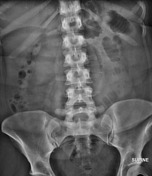Presentation
Abdominal pain, nausea and vomiting of one day duration.
Patient Data



The supine radiograph demonstrates dilatation of the small intestinal loops in the left upper abdomen.
The abdominal erect radiograph demonstrates multiple air fluid levels in the central and left upper part of the abdomen.

An umbilical hernia is seen with a thickened and trapped loop of small intestine within. Subsequent small bowel obstruction manifested by moderate dilatation of the small bowel proximally.
A small amount of abdominal free fluid.
Case Discussion
A hernia with trapped intestinal loops within that can no longer be pushed back into the abdominal cavity is called an incarcerated hernia. This can lead to intestinal obstruction and strangulation where emergency surgical intervention is required.




 Unable to process the form. Check for errors and try again.
Unable to process the form. Check for errors and try again.